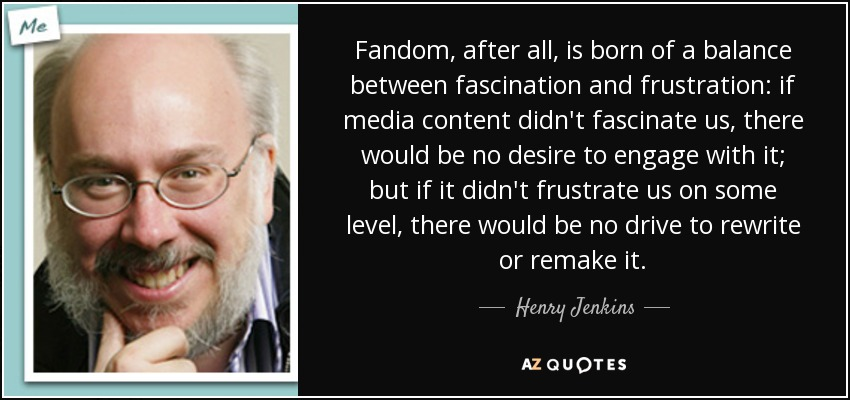Fans and fandom - exploring Henry Jenkins theories of fandom and participatory culture
Examples of ‘fannish behaviour’
- Discussing video games online, in forums, or even in person
- Buying merchandise Making videos and edits (fan films or fan edits)
- Visiting conventions, eg comicon (or Comiket in Japan)
- Modding communities. Changing things in the code of the game to make it different
- Watch streams of other players
- Fan art and fan fiction

Exploring examples of fan behaviour and participatory culture
Assassin's Creed Unity Meets Parkour in Real Life - 4K!
- In this video, a french freerunning community dress up in period costume, and reenact scenes from Assassin’s Creed Unity on the streets of Paris. The production values of this video are very high. The use of drone photography, handheld cinematography and other camera techniques are sophisticated. Setting the video in Paris is clearly illegal, and a great deal of preparation has gone into planning the route. The editing, soundtrack, and costumes are all sophisticated and of high quality. Lives have clearly been risked. Why? Because it’s fun. There is an overlap between fans of parkour and Assassin's Creed, and it provides an escapist fantasy for the target audience. Clearly influenced by the video games. Yet also offers a wider audience the escapism of seeing their favourite franchise in real life. Finally, there is a synergistic relationship between the game and the activities of the group. By using a popular franchise, the group gain more publicity and are able to produce more videos
AC15 UK Community Cosplay Competition
- Cosplay (costume play) is the process of making costumes and dressing up as characters from a pre existing franchise. It was popularised in Japan in the late 1970s and early 1980s, though now has international appeal. This process is highly enjoyable, and allows fans to immerse themselves in the narrative to a greater level. In addition, fans get a sense of community and greater social cohesion from playing a single player game. Friends can be made, and praise can be obtained through engaging in the franchise in this highly negotiated way.
- Even though these fan videos clearly infringe copyright, they synergistically help Ubisoft to advertise their product in a more sophisticated way
Assassin’s Creed WWII - A non-profit fan film set within the Assassin's Creed universe
- Surprisingly high production values, including the clearly choreographed action, the striking MES including real bunkers and a tank, and the period appreciate costumes
- A range of visual, digital FX, including gunfire and blood splatter means this fan film approaches a professional quality
- Yet the setting is clearly found, some costumes look like costumes, and a non-hegemonically attractive protagonist.
- Clearly a high amount of effort and a huge investment of time has gone in to this
- This film is clearly a labour of love and a special interest for the producers. Additionally, the producers will receive praise from other fans of the franchise.
- The makers of this video have constructed a fantasy assassin’s creed game that could not exist. WWII is far too recent to be dealt with in a straightforward manner by a mainstream game like this. The iconography of swastikas is potentially highly offensive to many audiences, and means the game could not maximise profit on a worldwide scale
Pony's Creed: Sisterhoof - a fan film combining elements of My Little Pony with Assassin’s Creed
- The trailer has been constructed using Flash animation, the same software used for the cartoon, giving a sense of authenticity. By combining elements of both properties, the makers of this video demonstrates their love for both products, and constructs a new comedic mode of address. Thi8s ironic parody is itself a popular form of entertainment. Also, the two products have wildly different fanbases. The producer has constructed a product where ponies have violent battles. In this way, the producer has made a childish franchise more adult and more relatable. Fan art is often based around a desire to see something lacking in the original product, and here have applied violent and adult elements to a franchise that is lacking it. This highly participatory form of engagement is typical of fans.